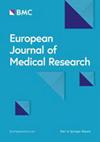新 BAST 评分与 FIB-4 指数在预测代谢功能障碍相关脂肪性肝病患者肝纤维化方面的诊断性能比较
IF 2.8
3区 医学
Q2 MEDICINE, RESEARCH & EXPERIMENTAL
引用次数: 0
摘要
代谢功能障碍相关性脂肪性肝病(MASLD)以前称为非酒精性脂肪肝(NAFLD),是全球最常见的肝病。FIB-4测试用于检测脂肪肝中的肝纤维化,但在预测肝硬变方面准确性有限,导致假阳性和假阴性率较高。新开发的 BAST 评分系统结合了腰围、谷草转氨酶和体重指数,用于评估非酒精性脂肪肝患者是否存在肝纤维化。本研究比较了 BAST 和 FIB-4 预测 MASLD 患者肝纤维化的有效性。研究纳入了140名接受瞬时弹性成像测量的非糖尿病MASLD患者。为每位患者计算BAST评分和FIB-4。根据肝纤维化严重程度对患者进行分组:F1、F2 和 F3-F4。使用接收器操作特征曲线评估了 BAST 评分和 FIB-4 的敏感性和特异性。从F1到F3-F4,BAST评分随着纤维化的进展而明显增加。在区分晚期纤维化(F2-F3)和轻度/中度纤维化(F1-F2)时,BAST评分的临界值≤-0.451显示出更好的诊断性能,其敏感性为90.70%,特异性为74.07%,PPV为84.8%,NPV为83.3%,而FIB-4的敏感性为60.47%,特异性为50.0%,PPV为65.8%,NPV为44.3%。同样,在区分 F1 和 F2 纤维化方面,临界值≤ - 1.11 的 BAST 评分优于 FIB-4,灵敏度为 80.23%,特异度为 79.49%,PPV 为 89.6%,NPV 为 64.6%,而 FIB-4 的灵敏度为 59.30%,特异度为 51.28%,PPV 为 72.9%,NPV 为 36%。与FIB-4相比,BAST评分能更好地预测MASLD中的肝纤维化,尤其是晚期肝纤维化或肝硬化病例。本文章由计算机程序翻译,如有差异,请以英文原文为准。
Diagnostic performance of new BAST score versus FIB-4 index in predicating of the liver fibrosis in patients with metabolic dysfunction-associated steatotic liver disease
Metabolic dysfunction-associated steatotic liver disease (MASLD) formerly known as non-alcoholic fatty liver disease (NAFLD) is the most common liver condition globally. The FIB-4 test is used to detect fibrosis in fatty liver disease but has limited accuracy in predicting liver stiffness, resulting in high rates of false positives and negatives. The new BAST scoring system, incorporating waist circumference, AST, and BMI, has been developed to assess the presence of fibrosis in NAFLD patients. This study compares the effectiveness of BAST and FIB-4 in predicting liver fibrosis in MASLD patients. The study included 140 non-diabetic MASLD patients who underwent transient elastography measurement. BAST score and FIB-4 were calculated for each patient. Patients were grouped based on fibrosis severity; F1, F2, and F3–F4. The sensitivity and specificity of the BAST score and FIB-4 were assessed using receiver operating characteristic curves. The BAST score increased significantly with fibrosis progression from F1 to F3–F4. In differentiating advanced fibrosis (F2–F3) from mild/moderate fibrosis (F1–F2), the BAST score at cutoff ≤ − 0.451 showed better diagnostic performance with 90.70% sensitivity, 74.07% specificity, 84.8% PPV and 83.3% NPV compared to FIB-4 that had 60.47% sensitivity, 50.0% specificity, 65.8% PPV and 44.3% NPV. Similarly, for differentiating between F1 and F2 fibrosis, the BAST score at cutoff ≤ − 1.11 outperformed FIB-4, with 80.23% sensitivity, 79.49% specificity, 89.6% PPV and 64.6% NPV, while FIB-4 had 59.30% sensitivity, 51.28% specificity, 72.9% PPV and 36% NPV. The BAST score is a better predictor of liver fibrosis in MASLD compared to FIB-4, especially in cases of advanced fibrosis or cirrhosis.
求助全文
通过发布文献求助,成功后即可免费获取论文全文。
去求助
来源期刊

European Journal of Medical Research
医学-医学:研究与实验
CiteScore
3.20
自引率
0.00%
发文量
247
审稿时长
>12 weeks
期刊介绍:
European Journal of Medical Research publishes translational and clinical research of international interest across all medical disciplines, enabling clinicians and other researchers to learn about developments and innovations within these disciplines and across the boundaries between disciplines. The journal publishes high quality research and reviews and aims to ensure that the results of all well-conducted research are published, regardless of their outcome.
 求助内容:
求助内容: 应助结果提醒方式:
应助结果提醒方式:


